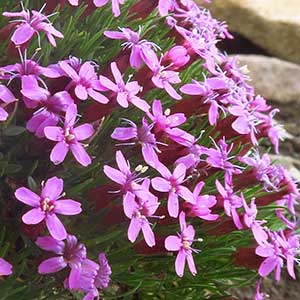Silene acaulis
Silene rectiramea
moss campion, silène acaule
Grand Canyon campion
several, erect from decumbent base, branched, 20–40 cm, sparsely scabrid-puberulent, stipitate-glandular distally.
erect, leafy proximally, 3–6(–15) cm, old leaves persistent at base.
mostly basal, densely crowded and imbricate, sessile;
blade 1(–3)-veined, linear-subulate to lanceolate, 0.4–1(–1.5) cm × 0.8–1.5(–2) mm, margins cartilaginous, often ciliolate especially proximally, apex acute, glabrous to scabrous.
2 per node;
basal shortly petiolate, blade oblanceolate, apex acute, sparsely puberulent;
cauline sessile, in 3–6 pairs, blade lanceolate to narrowly elliptic-lanceolate, 3–8 cm × 3–8 mm, apex acute, scabrid-puberulent.
solitary flowers.
cymose, open, branches few, ascending, elongate, 5–10 cm, flowers 1–3 per branch, bracteate;
bracts lanceolate, 3–5 mm, apex acute.
2–40 mm.
usually shorter than or to 11/2 times calyx, scabrous-puberulent, ± viscid.
bisexual or unisexual, all plants having both staminate and pistillate flowers, others having only pistillate flowers, subsessile or borne singly on peduncle;
calyx 10-veined, lateral veins absent, tubular to campanulate, (5–)7–10 mm, herbaceous, margins often purple tinged, dentate, sometimes ciliate, ± scarious, glabrous, lobes lanceolate to ovate, 1–2 mm;
petals bright pink, rarely white, limb unlobed to shallowly 2-fid, 2.5–3.5 mm, base tapered into claw, auricles and appendages poorly developed;
stamens exserted in staminate flowers, not so or aborted in pistillate flowers;
styles 3.
bisexual and unisexual, all flowers having bisexual flowers and staminate unisexual flowers, 6–8 mm diam.;
calyx prominently 10-veined, narrowly campanulate in flower, campanulate in fruit, 7–10(–11) × 4–6 mm, only slightly contracted around carpophore, papery and membranous, sparsely scabrid with short glandular-setose hairs, veins parallel, green, with pale commissures, margins dentate, lobes broadly ovate (as broad as long), 1–2 mm, not ciliate;
corolla cream or white, tinged purple, claw slightly exceeding calyx, narrowly triangular, auriculate, puberulent at base, limb oblong, 2-lobed, 2–4 mm, lobes entire, appendages 0.1–0.5 mm and broad, entire;
stamens equaling petals;
styles 3, equaling petals, reduced in functionally staminate flowers.
3-locular, cylindric, equaling or to 2 times calyx, opening by 6 recurved teeth;
carpophore ca. 1 mm.
ovoid-ellipsoid, equaling calyx, opening by 6 spreading teeth;
carpophore ca. 2 mm.
light brown, reniform, 0.8–1(–1.2) mm broad, dull, shallowly rugose.
brown, reniform-triangular, ca. 1 mm; papillate mainly around margin.
= 24.
Silene acaulis
Silene rectiramea
Silene acaulis is a variable species, and most workers have recognized infraspecific taxa in North America: subsp. acaulis (subsp. exscapa and subsp. arctica), which is predominantly arctic; and subsp. subacaulescens, which extends down the Rocky Mountains from Alaska to Arizona and New Mexico. In subsp. acaulis, the leaves are flat and short and the flowers are subsessile and smaller in size. Subspecies subacaulescens is typically a larger, less-compact plant with longer, narrower leaves and larger, pedunculate flowers. However, in many populations, these two variants are poorly differentiated, and in others both occur together, connected by intermediates.
Silene acaulis is widely distributed in arctic and alpine Europe.
(Discussion copyrighted by Flora of North America; reprinted with permission.)
Of conservation concern.
Silene rectiramea is found in the Grand Canyon in Arizona. It is very similar to forms of S. verecunda and to S. thurberi. It is distinguished by its smaller flowers and fruiting calyces that are not or only slightly constricted around the carpophore and tend to be more sparsely pubescent with broader, shorter lobes. Also the appendages smaller and entire.
(Discussion copyrighted by Flora of North America; reprinted with permission.)


